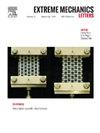Highly switchable and reversible soft sticky adhesives based on thermo-responsive phase separation
IF 4.5
3区 工程技术
Q2 MATERIALS SCIENCE, MULTIDISCIPLINARY
引用次数: 0
Abstract
Many biological systems can switch between strong adhering and non-adhering states to various materials with complex shapes and sizes in a reversible manner. By contrast, synthetic soft sticky adhesives, or pressure-sensitive adhesives, still face challenges in combining high switchability, reversible switching, facile switching operation, and applicability to diverse materials, shapes, and sizes. To address this challenge, here we present a highly switchable and reversible soft sticky adhesive based on thermal-induced phase separation in a thermo-responsive hydrogel. At room temperature, the hydrogel adhesive is toughened by nanoclay as noncovalent crosslinkers, showing an adhesion strength of 60–80 kPa to various adherends. This adhesion is almost completely switched off upon heating, with a residual strength of around 1 kPa. The switching is reversible for many cycles, enabling selective pick-and-release of objects with various materials, shapes, sizes, and weights. The switching time is around 10 s with an adhesive layer of 1 mm, governed by thermal conduction through the adhesive, faster than or comparable to most state-of-the-art methods. The adhesive is self-healing, and can be recycled, dried, stored, reswollen, and reused with nearly intact adhesion and switching properties. These features are hoped to advance technologies such as on-demand device disassembly for recycling, assembly-based manufacturing, biomimetic robots, and human-machine interfaces.
基于热响应相分离的高度可切换和可逆的软粘性粘合剂
许多生物系统可以以可逆的方式在各种形状和尺寸复杂的材料的强粘附和非粘附状态之间切换。相比之下,合成软粘胶粘剂或压敏胶粘剂在结合高可切换性、可逆切换、易于切换操作以及对不同材料、形状和尺寸的适用性方面仍然面临挑战。为了解决这一挑战,我们提出了一种高度可切换和可逆的软粘性粘合剂,该粘合剂基于热响应水凝胶中的热诱导相分离。在室温下,纳米粘土作为非共价交联剂对水凝胶胶粘剂进行增韧,对各种黏合剂的粘附强度为60-80 kPa。这种附着力在加热时几乎完全关闭,残余强度约为1kpa。这种切换在许多循环中是可逆的,可以选择性地拾取和释放各种材料、形状、大小和重量的物体。切换时间约为10 s,胶粘剂层厚度为1 mm,由胶粘剂的热传导控制,比大多数最先进的方法快或可与之媲美。该胶粘剂具有自愈性,可以回收、干燥、储存、再膨胀和重复使用,具有几乎完整的粘合和开关性能。这些特征有望推动诸如按需设备拆卸回收、基于装配的制造、仿生机器人和人机界面等技术的发展。
本文章由计算机程序翻译,如有差异,请以英文原文为准。
求助全文
约1分钟内获得全文
求助全文
来源期刊

Extreme Mechanics Letters
Engineering-Mechanics of Materials
CiteScore
9.20
自引率
4.30%
发文量
179
审稿时长
45 days
期刊介绍:
Extreme Mechanics Letters (EML) enables rapid communication of research that highlights the role of mechanics in multi-disciplinary areas across materials science, physics, chemistry, biology, medicine and engineering. Emphasis is on the impact, depth and originality of new concepts, methods and observations at the forefront of applied sciences.
 求助内容:
求助内容: 应助结果提醒方式:
应助结果提醒方式:


